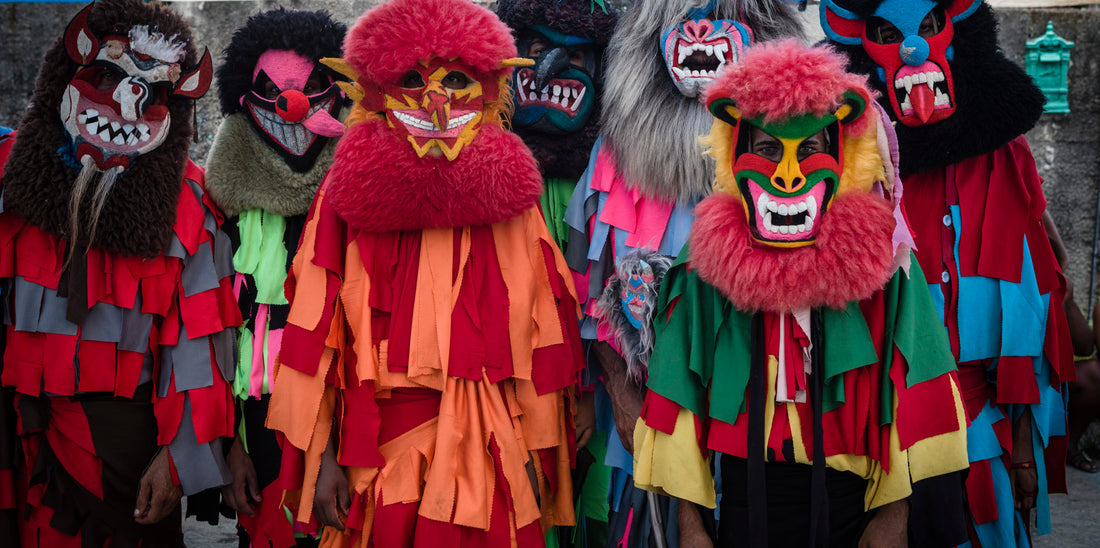
Folia dos Reis”
Brazilian “Folia dos Reis” The beauty of tradition, costumes, and music in celebration to Christ’s birth
“Folia dos Reis” is a Brazilian cultural ceremony and party that celebrates Christmas. It happens between 24 December to 6 January, when Christ's birth is remembered. This tradition is inherited from Portuguese influence during the colonial period in Brazilian territory. Textiles are used as a symbol of culture as well as to distiguish the different roles played throughout the celebration.The head of the “Folia dos Reis” is the folia’s Capitan who is responsible for organising the parade, and following the aim of the celebration, called “promessa.” This can be the cure of diseases, surpassing difficulties, etc. The “foliões,” people from the community, join the Capitan for the celebration; if there are many of them, a “Fiscal” helps with the organization. Dances, music and prays are a vital part of the parade. The traditional songs are played by the viola, cavaquinhos, drums, accordions and tambourines. The instruments are likely to be handmade and the costumes are made based on local traditions and legends.The most important piece of fabric in the ceremony is the flag or “estandarte”, which is called “Doutrina.” Its decoration varies accordingly to the Brazilian area where the folia is celebrated. A shiny and colourful fabric with colourful ribbons, flowers are normally the basic elements of the “Doutrina”. At the centre,a religious image is depicted. The ‘Doutrina” is a holly element, and it is treated with respect by all “foliões,” showing faith and devotion. The flag visits the houses and people honour it. At the beginning of the celebration, the flag is taken from its place of safe keeping, called the house of “festeiro,” where the flag will be returned at the end of the celebration.
 There are different personas in the parade, and each one is determined by their garment. The “Palhaço” (similar to a clown) wears colourful and patterned* clothes, and is responsible for entertaining people throughout the parade. An adorned and painted leather face mask is also part of the costume, which may or may not have a hat in a cone shape. The “foliões” dress in a vivid costume; which includes a white scarf, which represents the pureness of Jesus. The instruments are also adorned with colourful ribbons; each colour has a different meaning: yellow, pink and blue represent Holly Mary, and white represents the holy spirit. The end of the celebration is the “Remate” party. During this party, food and drinks are served and “foliões” and friends get together for a final celebration. Before and after the meal, speeches and prays celebrate the journey. At the end of the party, an undressing ritual is carried out, when “foliões” remove their costumes and kneel in respect to the “Doutrina”. At midnight a tribute to the Wise Men is carried out and the musical instruments are played until sunrise. The last moment happens when the “Canto da Entrega” (traditional song) is played and the “Doutrina” is given back to the godmother of the “folia,” normally a relative of the Capitan, who will keep the flag safe until the next year, when the “folia” starts once again.
There are different personas in the parade, and each one is determined by their garment. The “Palhaço” (similar to a clown) wears colourful and patterned* clothes, and is responsible for entertaining people throughout the parade. An adorned and painted leather face mask is also part of the costume, which may or may not have a hat in a cone shape. The “foliões” dress in a vivid costume; which includes a white scarf, which represents the pureness of Jesus. The instruments are also adorned with colourful ribbons; each colour has a different meaning: yellow, pink and blue represent Holly Mary, and white represents the holy spirit. The end of the celebration is the “Remate” party. During this party, food and drinks are served and “foliões” and friends get together for a final celebration. Before and after the meal, speeches and prays celebrate the journey. At the end of the party, an undressing ritual is carried out, when “foliões” remove their costumes and kneel in respect to the “Doutrina”. At midnight a tribute to the Wise Men is carried out and the musical instruments are played until sunrise. The last moment happens when the “Canto da Entrega” (traditional song) is played and the “Doutrina” is given back to the godmother of the “folia,” normally a relative of the Capitan, who will keep the flag safe until the next year, when the “folia” starts once again.
Marina Herriges

